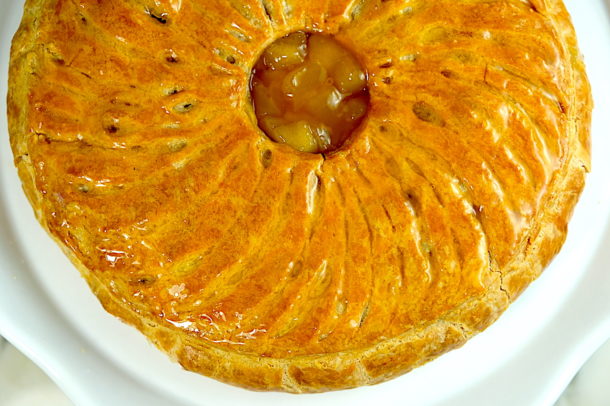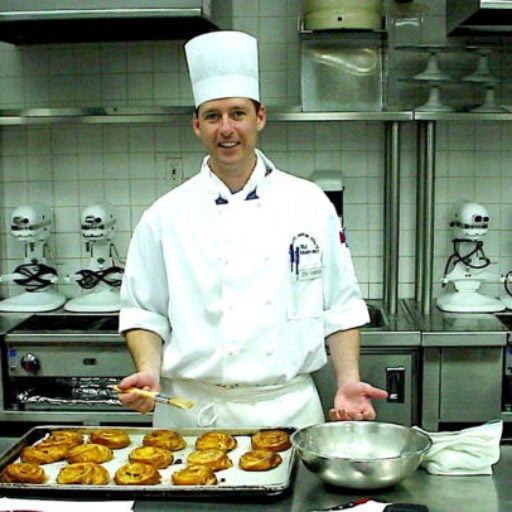My Rustic Apple Croustade has a simple crust, buttery, light, and flaky baked around an easy apple filling. I use the same filling as in my French Apple Tart, very simple with only apples, vanilla sugar, and a little lemon juice. No intense spices like an American apple pie, this croustade is all about the sweetness of the apples and the buttery flavor of the crust.
The smell of this free-form apple croustade baking will drive you nuts.
What makes a Flaky Pie Dough
A great pie begins with a crust that is light and flaky, yet strong enough to slice and serve. A delicate balancing act. Flaky Pie Dough like the one Grandma used to make, is actually quite controversial, everyone has an opinion about how to make the best pie dough. Everything from ingredients, type of equipment to use, hand mixing vs food processor, butter vs shortening, etc. etc. everything is debatable.
It is a pretty lengthy subject, so I will add it below the recipe, the info is there if you’re interested. Any way you slice it, I hope your crust is light and flaky.
Here is my recipe for a Rustic Apple Croustade

Rustic Apple Croustade
Ingredients
Pie Dough
- 1 3/4 Cups All-Purpose Flour
- 2 Eggs
- 9 Tablespoons Unsalted Butter 1/4-inch dice, very cold
- 1 Tablespoon Sugar
- 1/2 Teaspoon Salt
- 1 Teaspoon Vanilla Extract
Apple Filling
- 6 Apples Golden Delicious or Honeycrisp, 1/2-inch dice
- 1/2 Cup Granulated Sugar
- 1 Teaspoon Vanilla Extract
- 1 Lemon Juice only
- 1/2 Cup Water
Eggwash
- 2 Eggs Beaten
- 1 Teaspoon Water
Glaze
- 1/4 Cup Apricot Jam heated and strained
Instructions
Pie Dough
- Dice butter, place butter, flour, salt and sugar in the bowl of a food processor. Place the entire bowl in the freezer for 30 minutes.
- Put the flour and butter on the food processor and run for exactly 10 seconds
- Add the eggs and vanilla extract and run for exactly 10 seconds
- Gently knead the dough to collects all the crumbs, careful not to overwork it, form into a disk, wrap in plastic and refrigerate for at least 30 minutes.
Apple Filling
- Peel and core apples, then dice into 1/2-inch pieces, place all ingredients into a wide skillet over high heat, bring to a boil, stir once per minute until the water is evaporated.
- Spread the filling onto a cold sheet tray to cool
Assembling the Croustade
- Preheat oven to 350°F
- Divide the dough into equal halves. Roll the first half large enough to cut a 12-inch disc, approximately 1/4-inch thick. Roll the second half into a disc 8-inches in diameter. Place the 12-inch disc on a sheet tray lined with parchment
- Spoon the cooled filling into the center, and fold the edges up over the top of the filling, eggwash the edges of the crust and lay the smaller disc on the top. eggwash the top of the dough
- Use a round cutter to cut a hole in the center of the croustade, use the back of the knife to gently trace decorative lines into the crust
- Bake for approximately 1-hour, until the crust is golden brown
Glaze
- Heat the apricot jam and strain through a fine strainer (don't strain for even more rustic appearance). Brush the top of the croustade to give it a professional-looking shine and to finish it.

Nutrition
Thank you for visiting my Food Blog, I hope you enjoy my recipe for a Rustic Apple Croustade, please come back again soon! Bon appetit, Steven
What is ‘Shortening’?
The baking term ‘shortening’ refers to fat molecules that are solid at room temperature, they are used in baking to inhibiting the length of the gluten strands. The name ‘shortening’ was coined because it keeps the strands of gluten short. All fats can be ‘shortening’ however, most of us think of hydrogenated vegetable oils when we use the term ‘shortening’.
When you work with flour, the protein molecules (gluten) combine. The more you work and knead the flour the longer the strands, long strands are why rustic loaves of bread are chewy and have a hard crust. Short strands of gluten are why cookies, cakes, and pie doughs are light, crumbly, or flaky.
Vegetable Shortening vs Butter in Pie Dough
Hydrogenated vegetable oils, the solid, white waxy stuff that stays on the shelf for years without going bad, can perform miracles when baking. Light, flaky crusts, delicate cakes and cookies, light, fluffy easy to work with cake icing, all have beautiful results.
Too bad it doesn’t taste good.
To be perfectly honest, I hate hydrogenated vegetable oil shortening. Because shortening has a melting point of 115–120°F / 46-49°C it does not melt in your mouth or your stomach, ever.
I blame my dislike of shortening on the cheap grocery store birthday cakes with the ‘buttercream’ frosting made with vegetable shortening. Ugh, it’s awful.
Some people like a combination of butter and vegetable shortening, butter for flavor, shortening for tenderizing and flakiness. Again, I don’t like the flavor or mouth feel of shortening, so I don’t do this.
I like a combination of butter and eggs as the fat and the liquid in my dough. Adding eggs to a dough helps tenderize the dough and acts as a leavening agent. By freezing the butter and flour just before mixing, it keeps the butter more stable, leaving it in recognizable pieces resulting in a flakier crust. Eggs in the pie dough help make the dough easier to roll out and more pliable.
Butter melts at around 90–95°F / 32–35°C and therefore has a nicer mouth feel a better flavor. However, the low melting point makes it important to work quickly and with very cold ingredients.
Always Start and End with Cold Ingredients
I dice my butter into ¼-inch cubes with a knife, then place the butter, flour and mixing bowl in the freezer for 30 minutes. Cold eggs are also a must, although this recipe should not require any water, I have it in the ingredient list just in case.
Handle the dough as little as possible, your hands are hot enough to melt butter, which is no good for the finished product. I do 90% of the work with a food processor, then just gently combine the dough by hand at the end to bring it together.
Ice down the work surface. Sounds weird, but in the hotel kitchen it could hit 85–90°F, no matter how good your dough is, if you are rolling it out on a hot surface you’re going to have a tough crust. Place a sheet tray over the surface you plan on rolling the dough out on, fill with ice and let sit for 10 minutes. This is a simple trick that works magic.
Why is Your Pie Dough Tough?
A wet and sticky dough will result in a tough, and chewy crust. However, you don’t want the dough to be dry and crumbly either, it’s a fine balancing act.
Get to the point that your dough is a little dry and it crumbles when you pull it apart. Add a teaspoon of ice water at a time, and gently combine until you have a dough that forms a nice ball that doesn’t stick to your hands or crumble when you pull it apart
Cake Flour vs All-Purpose Flour
I use all-purpose flour for my pie dough. Flour is what holds it all together, you need it to have sufficient gluten for strength and structure. We want flaky pie dough, but at the same time, it needs to be strong enough to be able to serve your guests without falling apart.
